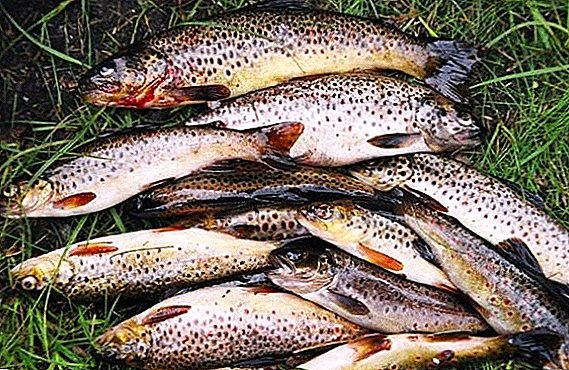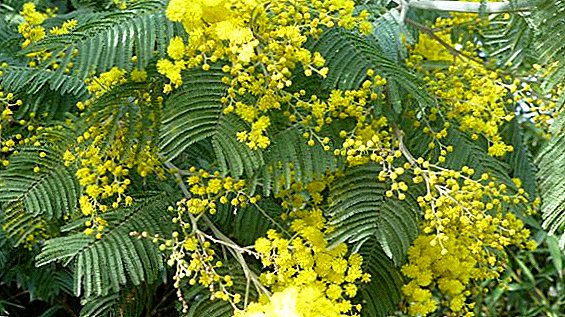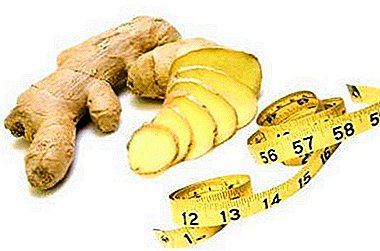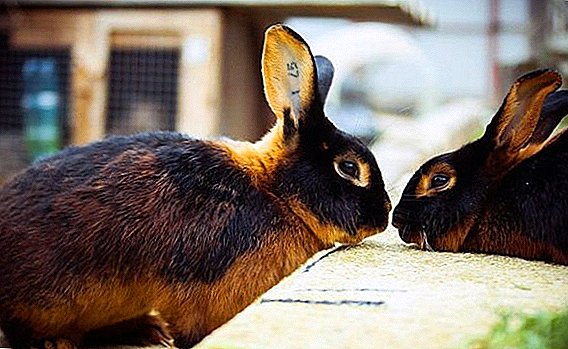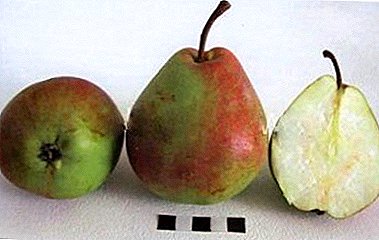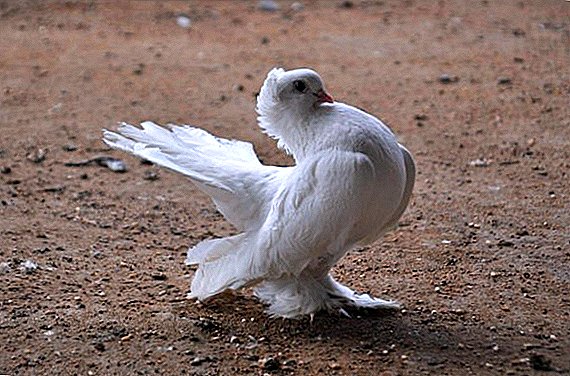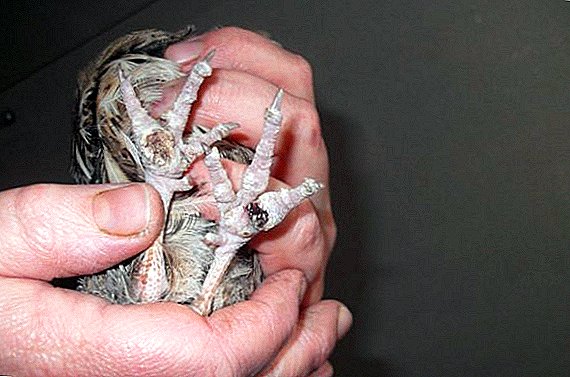 Knemidokoptoz in chickens is a lesion of the feet of birds with a yellow tick that penetrates the skin of a sick individual and, breaking through a deep canal, sits, feeding on the epidermis. This parasite breeds independently and in a favorable environment rather quickly. The disease has an incubation period of 4-6 months, after which it begins to develop rapidly. At an early stage, chickens are easily curable, so you need to carefully monitor your feathered herd.
Knemidokoptoz in chickens is a lesion of the feet of birds with a yellow tick that penetrates the skin of a sick individual and, breaking through a deep canal, sits, feeding on the epidermis. This parasite breeds independently and in a favorable environment rather quickly. The disease has an incubation period of 4-6 months, after which it begins to develop rapidly. At an early stage, chickens are easily curable, so you need to carefully monitor your feathered herd.
Causes of disease
In order for a bird to become infected with this species of tick, it is enough to get into the chicken coop at least one parasite. This can occur both from chickens that run in the open area, and from a person, because people often carry pathogens on their shoes and clothes. If a hen catches knemidokoptoz, other birds will surely catch it, because the bird family walks on one flooring, eats from the same feeder and sits on common perches. 
The reasons that influence the development of the disease are:
- dampness in the hen house;
- lack of hygiene in birds;
- dirty flooring;
- poor ventilation;
- contact with an infected object or individual.
Stages of development of the disease
Knemidokoptoz has three stages of development, on which depends the general condition of the bird, the symptoms of manifestation, as well as the complexity of the treatment itself.
Important! Knemidokoptoz can live outside of the carrier (animal) for several days.
Asymptomatic
As the name of the stage says, at this stage there are no symptoms of the disease. The duration of this period depends on many factors, mainly on the hygiene of the bird and its immunity. On average, an asymptomatic course of the disease lasts 5-6 months. During this period, the tick penetrates under the skin of the paws (under the hock).  Pliers
Pliers
Papular
The second stage lasts from one to two years. At this time, the paw begins to become covered with painful papules (small round gray growths), a thick layer of cornified skin appears. Over time, the bird begins to experience severe discomfort when walking, limping or alternately pressing the legs. The sooner the problem is identified at this stage, the easier it will be to get rid of the disease.
Did you know? The adult tick is most active at higher air temperatures. If you sharply reduce the temperature of the air, the parasite falls into hibernation.
Rustozna
The last and most dangerous stage comes a few years later. Feet of feathery become very dense and coarse, papules disappear in places, and a gray-bloody substance is released from the wounds. The chicken practically can not move. The neglect of such a state in a bird can even cause a loss of phalanges. 
Symptoms
The main symptoms of infection knemidokoptoza are:
- itching of the extremities (chickens trying to screw up their paws and scratch their feathers);
- weight loss (dehydration, exhaustion);
- loss of appetite;
- reduced immunity;
- unhealthy appearance of the skin of the paws (discoloration, appearance of growths);
- at the last stage, dying of the fingers is possible.
Find out why chickens are falling.
Medication treatment
There are many drugs that can get rid of tick infestation. Everyone has a certain active substance and features of use, however there are general rules for their use:
- The prepared solution must be heated (to activate the active substance) to + 38-42 ° С.
- As a container, it is better to use wide coxae in which it will be convenient to lower the legs of the hens.
- It is necessary to take the bird by the body, squeezing the wings tightly, put the whole paw into the basin with the solution before the feathering begins and hold for at least 60 seconds.
- After the time specified in the instructions, repeat the procedure.
Important! After the treatment of chickens by any of the preparations, it is necessary to carry out a general cleaning, as well as complete disinfection of the chicken house.
"Ectomin"
This medicine comes in the form of a thick liquid, the main component of which is a synthetic insecticide. To prepare the solution it is necessary to dissolve 1 ml of the drug in a liter of pure water. The procedure is repeated after 5 days. 
"Trichlormetafos"
The drug has an oily texture, the main substance - pyrethroid. This component not only kills adult ticks, but also larvae. It also helps to clean the excrement-affected canals that the parasite has penetrated. To prepare the solution per liter of pure water, you must take 10 ml of the drug. The procedure is repeated after 5 days.
In order to treat and prevent this disease, use drugs such as: "Akarin" and "Promectin".
"Butox"
"Butox" is available in ampoules and is considered one of the most effective drugs. The active ingredient allows you to kill a large number of larvae at a time, and if not to kill adults the first time, then weaken them greatly. When re-applied after 10 days, the manufacturer promises a 100 percent result. To prepare the solution, 1 ampoule must be dissolved in 1.3-1.5 liters of pure water. 
"Mara-sad"
The drug is an oily liquid (ready solution). Allows you to get rid of bacteria, parasites, and also accelerates the process of regeneration of the skin. It is necessary to use it three times with a break of a week.
"Akarin"
Unlike all of the above drugs, "Akarin" is a gel, which must be processed directly paws of birds.
Learn how to deal with leg diseases in chickens.
Front Line
Excellent tool (sold in the form of a spray), which should be applied directly to the affected areas of the legs of the bird. It is advisable to wear a respirator before applying and protect yourself from getting into the eyes of the substance.
Treatment of folk remedies
It is not always possible to treat poultry with expensive drugs. However, this does not mean that the chicken can not help. The bird will come to the aid of a proven tool for centuries - birch tar. The use of this substance is difficult to overestimate, because it has excellent antibacterial properties that help get rid of bacteria, as well as create an unfavorable environment for them. 
To treat knnemidocoptosis in chickens with birch tar, do the following:
- First, feet feathered well washed. To do this, you must use a concentrated solution of household soap, in which the chicken immerses the paws for 10-15 minutes.
- After the paws are dry, they need to be generously smeared with tar.
- Depending on the condition, the procedure must be repeated 3-4 times at weekly intervals.
Did you know? During feeding, the mass of the tick can increase by 100 or even 150 times.
Prevention
To prevent the occurrence and development of the tick, you must adhere to the following simple rules:
- The chicken coop should be cleaned at least once a day. General cleaning and replacement of the flooring should be done every week.
- The house should be equipped with a working, sufficiently powerful ventilation system.
- If there is at least minimal suspicion of the presence of the disease, the chicken should be urgently examined or shown to a specialist.
- Bathing a bird is not just a whim. Clean birds rarely suffer from such diseases.
 So, having understood the causes of the disease, it can be concluded that knemidokoptoz in birds is a disease that occurs in the absence of proper hygiene of both the chicken and the chicken coop. If the basic rules of cleanliness are observed, the risk of hitting the paws with this tick is almost completely reduced, and if infection has happened, it is important to determine it as soon as possible, then it will be much easier to get rid of the disease without any particular consequences.
So, having understood the causes of the disease, it can be concluded that knemidokoptoz in birds is a disease that occurs in the absence of proper hygiene of both the chicken and the chicken coop. If the basic rules of cleanliness are observed, the risk of hitting the paws with this tick is almost completely reduced, and if infection has happened, it is important to determine it as soon as possible, then it will be much easier to get rid of the disease without any particular consequences.


